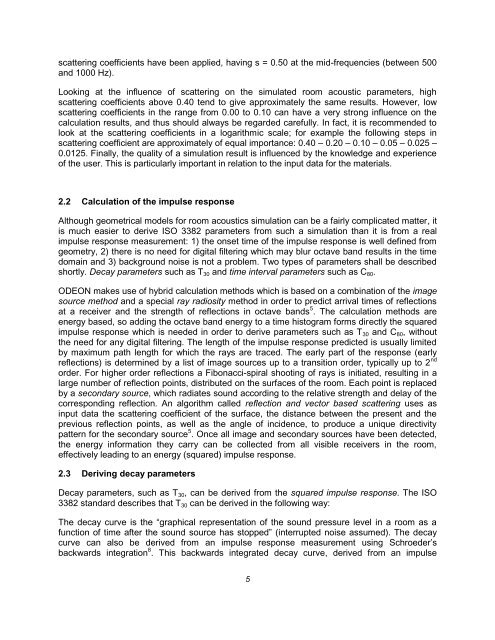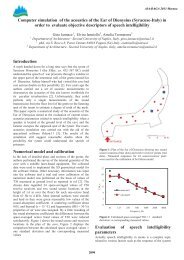paper - Odeon
paper - Odeon
paper - Odeon
Create successful ePaper yourself
Turn your PDF publications into a flip-book with our unique Google optimized e-Paper software.
scattering coefficients have been applied, having s = 0.50 at the mid-frequencies (between 500<br />
and 1000 Hz).<br />
Looking at the influence of scattering on the simulated room acoustic parameters, high<br />
scattering coefficients above 0.40 tend to give approximately the same results. However, low<br />
scattering coefficients in the range from 0.00 to 0.10 can have a very strong influence on the<br />
calculation results, and thus should always be regarded carefully. In fact, it is recommended to<br />
look at the scattering coefficients in a logarithmic scale; for example the following steps in<br />
scattering coefficient are approximately of equal importance: 0.40 – 0.20 – 0.10 – 0.05 – 0.025 –<br />
0.0125. Finally, the quality of a simulation result is influenced by the knowledge and experience<br />
of the user. This is particularly important in relation to the input data for the materials.<br />
2.2 Calculation of the impulse response<br />
Although geometrical models for room acoustics simulation can be a fairly complicated matter, it<br />
is much easier to derive ISO 3382 parameters from such a simulation than it is from a real<br />
impulse response measurement: 1) the onset time of the impulse response is well defined from<br />
geometry, 2) there is no need for digital filtering which may blur octave band results in the time<br />
domain and 3) background noise is not a problem. Two types of parameters shall be described<br />
shortly. Decay parameters such as T 30 and time interval parameters such as C 80 .<br />
ODEON makes use of hybrid calculation methods which is based on a combination of the image<br />
source method and a special ray radiosity method in order to predict arrival times of reflections<br />
at a receiver and the strength of reflections in octave bands 5 . The calculation methods are<br />
energy based, so adding the octave band energy to a time histogram forms directly the squared<br />
impulse response which is needed in order to derive parameters such as T 30 and C 80 , without<br />
the need for any digital filtering. The length of the impulse response predicted is usually limited<br />
by maximum path length for which the rays are traced. The early part of the response (early<br />
reflections) is determined by a list of image sources up to a transition order, typically up to 2 nd<br />
order. For higher order reflections a Fibonacci-spiral shooting of rays is initiated, resulting in a<br />
large number of reflection points, distributed on the surfaces of the room. Each point is replaced<br />
by a secondary source, which radiates sound according to the relative strength and delay of the<br />
corresponding reflection. An algorithm called reflection and vector based scattering uses as<br />
input data the scattering coefficient of the surface, the distance between the present and the<br />
previous reflection points, as well as the angle of incidence, to produce a unique directivity<br />
pattern for the secondary source 5 . Once all image and secondary sources have been detected,<br />
the energy information they carry can be collected from all visible receivers in the room,<br />
effectively leading to an energy (squared) impulse response.<br />
2.3 Deriving decay parameters<br />
Decay parameters, such as T 30 , can be derived from the squared impulse response. The ISO<br />
3382 standard describes that T 30 can be derived in the following way:<br />
The decay curve is the “graphical representation of the sound pressure level in a room as a<br />
function of time after the sound source has stopped” (interrupted noise assumed). The decay<br />
curve can also be derived from an impulse response measurement using Schroeder’s<br />
backwards integration 8 . This backwards integrated decay curve, derived from an impulse<br />
5
















